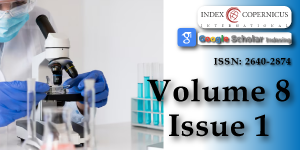The Accuracy of pHH3 in Meningioma Grading: A Single Institution Study
Main Article Content
Abstract
Introduction: In the latest WHO classification of central nervous system tumors, Mitotic Index (MI) counted on Phosphohistone-H3 stained slides (pHH3-MI) has been suggested as a valid proliferative marker in various tumors including in the evaluation of meningioma grading.
We aim to report our own experience in assessing the efficiency of the anti-pHH3 antibody as a grading tool for meningiomas.
Methods: A retrospective study was conducted on a series of 40 meningiomas diagnosed from March 2020 to April 2021 at the Pathology Department of the Military Hospital of Tunis. We attempted immunohistochemistry and compared MI assessed on both pHH3 and HE-stained slides.
Results: According to the HE-MI and pHH3-MI, the 40 cases of meningiomas were respectively divided into 35 versus 29 grade 1 cases, four versus eight grade 2 cases, and one versus three grade 3 cases. A highly significant correlation was found between pHH3-MI and HE-MI (p < 0.001). A significantly higher sensitivity in the pHH3 counting method was reported in our study.
Discussion: we found, in accordance with the literature, that pHH3-MI is more reliable and accurate in mitotic counting, therefore exhibiting a high sensitivity in tumor grading, reported by an upgrade within 22,5% of the cases.
Conclusion: PHH3-MI count facilitated a rapid reliable grading of meningiomas. However, molecular characteristics that could have a potentially significant impact on tumor progression should be the subject of further research.
Article Details
Copyright (c) 2024 Nada M, et al.

This work is licensed under a Creative Commons Attribution 4.0 International License.
Louis DN, Perry A, Wesseling P, Brat DJ, Cree IA, Figarella-Branger D, Hawkins C, Ng HK, Pfister SM, Reifenberger G, Soffietti R, von Deimling A, Ellison DW. The 2021 WHO Classification of Tumors of the Central Nervous System: a summary. Neuro Oncol. 2021 Aug 2;23(8):1231-1251. doi: 10.1093/neuonc/noab106. PMID: 34185076; PMCID: PMC8328013.
Puripat N, Loharamtaweethong K. Phosphohistone H3 (PHH3) as a surrogate of mitotic figure count for grading in meningiomas: a comparison of PHH3 (S10) versus PHH3 (S28) antibodies. Virchows Arch. 2019 Jan;474(1):87-96. doi: 10.1007/s00428-018-2458-2. Epub 2018 Sep 29. PMID: 30267302.
Saffar H, Okhovat H, Arbabsoleymani S, Tavangar SM, Khoshnevisan A, Hajinasrollah G, Hamidi Afra Z, Saffar H. The Utility of Phosphohistone H3 in Inter-Observer Variability of Mitotic Count in Meningioma, is There Any Benefit? Asian Pac J Cancer Prev. 2021 Jul 1;22(7):2049-2052. doi: 10.31557/APJCP.2021.22.7.2049. PMID: 34319026; PMCID: PMC8607091.
Perry A, Stafford SL, Scheithauer BW, Suman VJ, Lohse CM. Meningioma grading: an analysis of histologic parameters. Am J Surg Pathol. 1997 Dec;21(12):1455-65. doi: 10.1097/00000478-199712000-00008. PMID: 9414189.
Fukushima S, Terasaki M, Sakata K, Miyagi N, Kato S, Sugita Y, Shigemori M. Sensitivity and usefulness of anti-phosphohistone-H3 antibody immunostaining for counting mitotic figures in meningioma cases. Brain Tumor Pathol. 2009;26(2):51-7. doi: 10.1007/s10014-009-0249-9. Epub 2009 Oct 27. PMID: 19856215.
Elmaci İ, Altinoz MA, Sari R, Bolukbasi FH. Phosphorylated Histone H3 (PHH3) as a Novel Cell Proliferation Marker and Prognosticator for Meningeal Tumors: A Short Review. Appl Immunohistochem Mol Morphol. 2018 Oct;26(9):627-631. doi: 10.1097/PAI.0000000000000499. PMID: 28777144.
Wiemels J, Wrensch M, Claus EB. Epidemiology and etiology of meningioma. J Neurooncol. 2010 Sep;99(3):307-14. doi: 10.1007/s11060-010-0386-3. Epub 2010 Sep 7. PMID: 20821343; PMCID: PMC2945461.
Marosi C, Hassler M, Roessler K, Reni M, Sant M, Mazza E, Vecht C. Meningioma. Crit Rev Oncol Hematol. 2008 Aug;67(2):153-71. doi: 10.1016/j.critrevonc.2008.01.010. Epub 2008 Mar 14. PMID: 18342535.
Duregon E, Cassenti A, Pittaro A, Ventura L, Senetta R, Rudà R, Cassoni P. Better see to better agree: phosphohistone H3 increases interobserver agreement in mitotic count for meningioma grading and imposes new specific thresholds. Neuro Oncol. 2015 May;17(5):663-9. doi: 10.1093/neuonc/nov002. Epub 2015 Feb 1. PMID: 25646026; PMCID: PMC4482862.
Ozek E, Akdag H, Tosuner Z, Abdallah A, Hatiboglu MA. The correlation between phosphorylated Histone H3 (PHH3) and p-STAT3 in Meningiomas. Clin Neurol Neurosurg. 2019 Mar;178:46-50. doi: 10.1016/j.clineuro.2019.01.016. Epub 2019 Jan 25. PMID: 30710729.
Kim YJ, Ketter R, Steudel WI, Feiden W. Prognostic significance of the mitotic index using the mitosis marker anti-phosphohistone H3 in meningiomas. Am J Clin Pathol. 2007 Jul;128(1):118-25. doi: 10.1309/HXUNAG34B3CEFDU8. PMID: 17580279.
Samadi N, Ahmadi SA. Meningioma: a clinicopathological evaluation. Malays J Med Sci. 2007 Jan;14(1):46-52. PMID: 22593651; PMCID: PMC3351217.
Ribalta T, McCutcheon IE, Aldape KD, Bruner JM, Fuller GN. The mitosis-specific antibody anti-phosphohistone-H3 (PHH3) facilitates rapid reliable grading of meningiomas according to WHO 2000 criteria. Am J Surg Pathol. 2004 Nov;28(11):1532-6. doi: 10.1097/01.pas.0000141389.06925.d5. PMID: 15489659.

